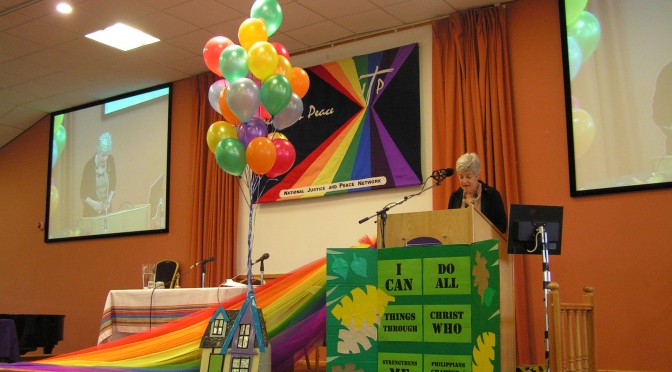
How to…..Set up a Display
Our ‘How To’ series is developed to help start/develop your justice and peace group and are all available on the resources page.
3. How to set up a display.
Displays can be very useful for engaging the attention of people who don’t already have an interest in the issue with which you are concerned.
You can use a display to do the following:
Inform: tell people about a situation or an event, or about an organisation.
Educate: explain the facts to people and show the causes of problems.
Politicise: show how a particular issue is related to wider political issues.
Mobilise: ask people to do something.
Advertise: tell people about an event.
Before you begin, ask the following questions:
Who is it for? (target group)
What should it say? (the content).
Designing a Display
A display must be designed in such a way that it catches people’s attention. You want people to see the display and spend some time looking at it.
Size: an eye-catching, small exhibition may be better than a large untidy one. Where you are going to locate the display will determine the size. You should tailor the size of the writing/illustrations to the space available. Do a rough design – this should show where the words, drawings and logos will be, how big they will be and the colours you will use.
Shape: the display could be flat or three dimensional.
Visuals: people will often see the picture first, so good photos, maps or other drawings are essential. Your diocesan fieldworker or an appropriate agency may be able to help with all three. Make sure the illustrations match the text. It is important that visuals are large and access to a photocopier which enlarges would be useful. Colour grabs attention, but be careful that the final display is not gaudy. Backing sheets, for example, should be in one colour or complementary colours.
Text: it is vital that the text is kept to a minimum. Once you have decided what you want to say, work on the shortest way of saying it. Sometimes just a few words can be very effective: for example, ‘Time Is Running Out’ in large letters, with surrounding pictures of how our present lifestyle is damaging our environment.
Mood: the most effective displays are those which are generally positive rather than negative. Some environmental issues such as global warming, e.g., terrify some people and the exhibition should motivate people to act rather than simply frighten them. The example given immediately above would be most useful if it was counterbalanced by a second display using the wording ‘Building a Better Future’ and displaying positive images of people working for change.
Location: very often people place exhibitions at the back of the church because that is where space is allocated. However, other locations could be considered: the pulpit, lectern or pillars in the church could display a selection of posters or long, narrow graphics. Since people face the front during the service in rectangular churches, the congregation can hardly ignore the posters. Avoid vague posters which distract and annoy people.
Timing: It is sensible to time the display to coincide with something relevant, e.g. CAFOD Fast Day, One World Week, Christian Aid Week, special Sundays e.g. Homelessness Sunday, Racial Justice Sunday etc. An exhibition should be shown for a limited time only. People get bored with looking at something for more than three weeks and associate the theme with their boredom. A permanent display should be regularly updated. A poster on a lectern could be changed every week to give a variety of thoughts connected to the issue. Posters and other useful materials can be obtained from organisations mentioned in the “Useful Addresses” Section or via the External Contacts links at www.justice-and-peace.org.uk.
At the end of the display, you could incorporate details of any follow up, action ideas, dates of meetings etc.
A Few Ideas
A very simple display can be made to look attractive simply by having a colourful, striking backdrop.
If you have access to a photocopier which enlarges and reduces, enlarged type-written text looks more professional and can be read more easily than handwriting.
If you have photographs of people from the parish involved in some kind of activity linked to the Campaign, they could give your display a good local interest. Other ideas in this line might include items from the parish newsletter, posters advertising training days etc.
A challenging title (such as a question) is a good way of attracting people to look at the display.
You might like to experiment with different shapes for the ‘panels’ which make up the display. For example, panels could be shaped like a jigsaw which needs to be fitted together.
Enlist the help of creative people in the parish. The standard of your display will improve and you will have involved more people in the campaign.
Do:
- Get permission to put up your display
- Be realistic about how much you can do and say
- Design your display before you begin
- Identify your target audience
- Make it simple and clear
- Make sure the message stands out
- Be as consistent as possible with style
- Make good use of things you already have available
- Use your imagination
- Make sure it is colourful and eye-catching, but not gaudy
- Use photos, graphics and cartoons
- Use enlarged text (preferably printed)
- Suggest some kind of further action/enquiry/local contact
- Have something for people to take away with them
- Decide who will set up the display and who will take it down
Don’t:
- Don’t try to say everything – just the key points/issues
- Don’t squash too many things together – a clear layout is vital
- Don’t have too much text – this may look too heavy-going
- Don’t block out any other group’s notices etc.



